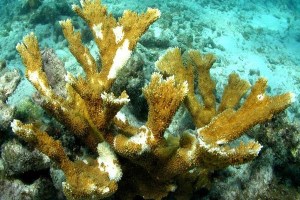
Infected elkhorn coral. Credit: James W. Porter / University of Georgia / AFP / Getty Images
Usually infectious disease is a one-way street—and human beings are at the end. New viruses begin in wild animals—like monkeys or chickens—before they mutate and cross over to human beings. HIV, West Nile, SARS, H5N1, H1N1—just about every new infectious disease over the past several decades had its start in animals before infecting people. “We’re in a unique time because the world is completely globalized now,” says Peter Daszak, the president of the EcoHealth Alliance, a non-profit that works on the intersection between animal and human health. “New pathogens arise out of this border between wildlife and humans.”
But it turns out the traffic can run the other way too—at least occasionally. In a study published in the journal PLoS ONE, researchers from the University of Georgia and Rollins College in Florida confirmed that a human pathogen was infecting and killing corals in the Florida Keys. Scientists had already known the bacterium Serratia marcescens caused the coral disease “white pox,” which produces lesions that eat away at the elkhorn coral in the Carribbean—so much so the coral is now listed under the Endangered Species Act. But the PLoS ONE team, led by Kathryn Sutherland of Rollins College, managed to determine that the bacterium originates in human beings, and that the human sewage spread the disease—which provides hope that we might be able to stop it.
More from TIME: Outbreak.com
The research team analyzed human samples of the bacterium from wastewater treatment facilities in Key West, as well as samples from other animals that can carry the pathogen, like the Key deer. While Serratia marcesens was found in animals, the strains infecting the corals only matches samples taken from human waste. Sewage was the means of transmission—which means our waste was killing the coral, as study co-author James Porter of the University of Georgia said:
Bacteria from humans kill corals—that’s the bad news. But the good news is that we can solve this problem with advanced wastewater treatment facilities. This problem is not like hurricanes, which we can’t control. We can do something about this one.
But while U.S. might clean up its wastewater–Key West just spent $70 million a better treatment facility—other countries in the Caribbean have been less vigilant. And disease is just one of the many threats facing corals around the world, from overfishing to climate change to acidification. Coral reefs are the rain forests of the sea, home to amazing marine biodiversity. The least we can do is stop making them sick.
More from TIME: Our Dying Corals—and How to Save Them
Bryan Walsh is a senior writer at TIME. Find him on Twitter at @bryanrwalsh. You can also continue the discussion on TIME’s Facebook page and on Twitter at @TIME.


